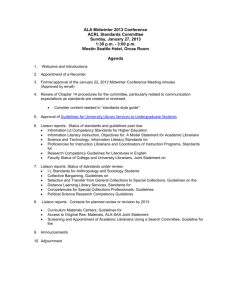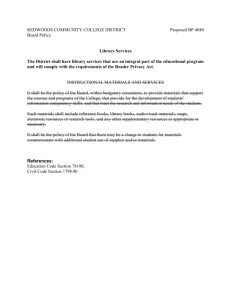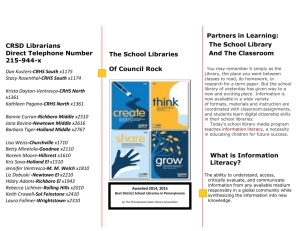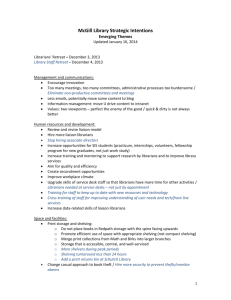Systemwide Strategic Directions for Libraries
advertisement
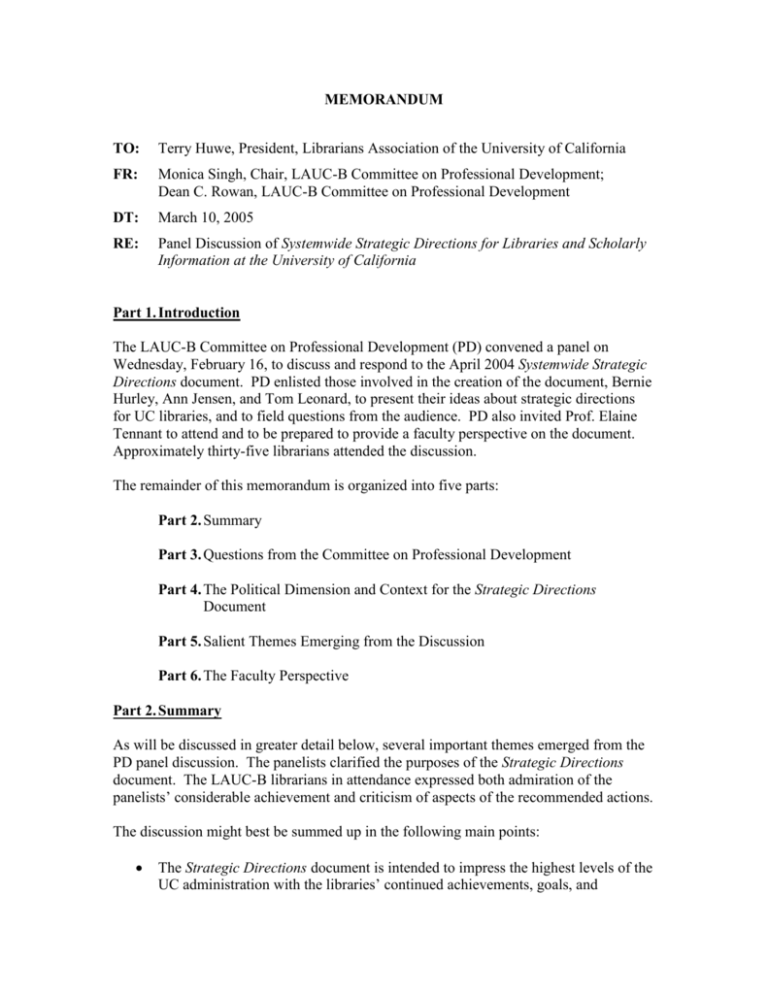
MEMORANDUM TO: Terry Huwe, President, Librarians Association of the University of California FR: Monica Singh, Chair, LAUC-B Committee on Professional Development; Dean C. Rowan, LAUC-B Committee on Professional Development DT: March 10, 2005 RE: Panel Discussion of Systemwide Strategic Directions for Libraries and Scholarly Information at the University of California Part 1. Introduction The LAUC-B Committee on Professional Development (PD) convened a panel on Wednesday, February 16, to discuss and respond to the April 2004 Systemwide Strategic Directions document. PD enlisted those involved in the creation of the document, Bernie Hurley, Ann Jensen, and Tom Leonard, to present their ideas about strategic directions for UC libraries, and to field questions from the audience. PD also invited Prof. Elaine Tennant to attend and to be prepared to provide a faculty perspective on the document. Approximately thirty-five librarians attended the discussion. The remainder of this memorandum is organized into five parts: Part 2. Summary Part 3. Questions from the Committee on Professional Development Part 4. The Political Dimension and Context for the Strategic Directions Document Part 5. Salient Themes Emerging from the Discussion Part 6. The Faculty Perspective Part 2. Summary As will be discussed in greater detail below, several important themes emerged from the PD panel discussion. The panelists clarified the purposes of the Strategic Directions document. The LAUC-B librarians in attendance expressed both admiration of the panelists’ considerable achievement and criticism of aspects of the recommended actions. The discussion might best be summed up in the following main points: The Strategic Directions document is intended to impress the highest levels of the UC administration with the libraries’ continued achievements, goals, and objectives in the hope that there will be substantial support for libraries at the UCOP level. While libraries are the focus of the document, there ought to be more emphasis on librarians and staff in pursuing recommended actions. Berkeley’s reputation to scholars and students rests in part on the uniqueness of the Berkeley library collections. This uniqueness must be maintained in the shared collection future. Collection sharing policies need refining so that immediate campus library users have optimal access to their libraries’ collections. Collection development should reflect a balance of current curriculum and teaching, and the need for an enduring research-level collection. The level of cooperation and organization among the libraries and librarians is high. Library users need continued education regarding research skills and new technologies. Hard copy and electronic resources should complement each other. These views are evidently shared, to varying degrees, by librarians and faculty alike. Part 3. Questions from the Committee on Professional Development In advance of the discussion, PD submitted a series of questions to the panelists, indicating general areas of concern or uncertainty regarding the Strategic Directions document. Those questions were: There has been something of a rumor floating about that the document was drafted for “political” reasons, presumably referring to state budget concerns. Can you please clarify, confirm, or deny this matter? How does the document's “political” nature invite us to regard its substance? We would like to see this discussion focus on the librarian as well as the Library, particularly since ours is the Professional Development Committee. Should we be discussing strategic directions and roles for librarians also? How about funding and time for continuing education for librarians in light of the strategic directions? Do the strategic directions indicate a need for further inter-campus tours/rotations to allow librarians to familiarize themselves with the people and divisions with whom we will share the future library? How might this be funded? The document appears to advocate a “do more with less” approach to progress. Are there alternative approaches, such as fundraising or lobbying those who handle the budgets? -2- Although these questions did not structure the progress of the discussion, they informed the panelist’s presentations, and were largely addressed either explicitly or implicitly. Additionally, librarians in the audience touched on many of these themes as well. Part 4. The Political Dimension and Context for the Strategic Directions Document At the outset, Ann Jensen noted that the “political” dimension of the Strategic Directions document reflects the authors’ intention to speak to “the highest levels of the Office of the President,” as well as to state politicians. The document is intended to acknowledge that new technologies can lead to economies of scale in collection development. Admittedly, libraries have already been engaged in the kinds of actions recommended. In this respect, the document takes into account what librarians have already accomplished regarding sharing of collections, technology, and services. Because there is much competition for resources across all levels of the University of California, the document helps the libraries to make their case. Bernie Hurley identified three intended audiences: University Librarians The Office of the President Library staff He noted that the last push of this sort led to CDL. The document, therefore, is intended to continue the move forward. Part 5. Salient Themes Emerging from the Discussion A. Professional Development and the Centrality of Librarians to Libraries An overriding LAUC-B concern related to the omission from the document of the significance of support staff, both librarians and staff, to the quality of our collections. Collections must be selected, processed, and made available by skilled staff members. Granted, there are scattered remarks in the Strategic Directions discussion regarding the importance of staff, but the document clearly emphasizes “libraries,” “collections,” “facilities,” “services,” and “digital materials,” rather than the professional skills and development of librarians. The recommended actions regarding outreach to faculty with respect to scholarly communication only implicitly involve library staff. Thus, the document fails to make clear that a concomitant demand for staffing proceeds from the need to continue to fund and build collections. Instead, this staffing component is relegated to the notion of an unspecified “invisible infrastructure” to which no strategic directions directly apply. Professional development of librarians remains implicit in the document when it should be an explicit, high-priority recommendation. Librarians are essentially expected to carry out the recommended actions without being provided with the necessary tools. Furthermore, adequate levels of staffing are required to provide timely access to the collections. -3- Although the question of inter-campus tours and rotations by librarians and staff was only briefly addressed during the panel discussion, it is clear that these are among the professional development steps that should be taken. The sharing of collections, facilities, and services recommended by the Strategic Directions document entails a corresponding promotion of interoperability among personnel and organizational divisions. B. Shared Facilities and Services Addressing the Strategic Directions recommended action with respect to shared facilities, Bernie Hurley noted that there is now already one RLF board and that the recommended actions were designed to help ensure that SRLF Phase 3 is built in a timely manner. LAUC-B librarians expressed concern that this consolidation of the RLF boards could adversely affect the future of the persistence policy, a concern related as well to shared collections (discussed further below). In response, Bernie noted that Berkeley indeed contributes significantly, but reaps benefits, too. For example, persistence is good for Berkeley librarians, as it insures that when another campus has been the first to place a book in storage, Berkeley can safely discard its copy, confident that the storage copy will persist. With respect to shared services, he noted the “layered” services approach, permitting a central infrastructure (based at CDL), with local campus customization. However, it is unclear to LAUC-B librarians precisely which kinds of services are envisioned by the Strategic Directions document as most suitable for this “layered” approach. C. Shared Collections While LAUC-B librarians acknowledge the importance and longstanding tradition of sharing of materials, we also want Berkeley’s materials to continue to belong to Berkeley, signifying the special quality, breadth, and depth of the university’s research and educational missions. This significance is an important attraction to students and faculty to Berkeley. Sharing can threaten certain areas of the collection. Copies of current and core materials, for example, are often requested by other campuses before enjoying substantial use here at Berkeley, where they were purchased. The result is degradation in service to Berkeley patrons. Two librarians noted that they routinely review all ILL requests in order to catch these kinds of requests. On the other hand, each campus may have its own demands for unique collections, for which it would be unfair or inefficient to expect other campuses to share the costs. Bernie Hurley agreed that “shared collections” has indeed been a contentious issue in the evolution of the Strategic Directions document. The solution has been to establish “voluntary contributions with shared governance.” The ambiguous nature of “governance” has been clarified by an MOU, he reported. Additionally, some formats -4- are better shared than others. Prospective monographic print materials may not be as amenable to a shared collection as digital formats. D. Curriculum and Collections An important theme of the discussion addressed the need for the evolving curriculum to drive the evolution of collection policies. Trends in research and teaching should inform, but not absolutely dictate, collection decisions. Libraries routinely engage in strategic planning, locally and statewide, but there is no similar curricular planning. We try to match our collections to what is being taught, but the effort is nowhere coordinated. Tom Leonard remarked that the libraries’ coordinated goals and operations vastly outpace any analogous coordination among the faculty respecting the curriculum. An ideal “real time” correspondence, then, between curriculum and collection would not likely be achieved. Furthermore, Berkeley’s research mission should also continue to inform collection practices. Similarly, when one librarian asked whether the faculty who plan the curricula have any coordination across campuses, Elaine Tennant replied with an emphatic, “No!” The librarians’ largely informal coordination mechanism, exemplified in the way that groups of bibliographers confer and work together across campuses, is not practiced by faculty. Lack of curriculum coordination thus provides the libraries with very little on which to formulate a plan. E. Information Literacy An anecdote about a reference to Google Scholar appearing on a graduate student’s web site prompted discussion about another issue inadequately addressed in the Strategic Directions document, the need for instruction and information for researchers regarding the quality of information resources. Tom Leonard responded that “Dan Greenstein [UL of CDL] is constantly thinking about how to provide better access tools.” LAUC-B librarians note that knowledgeable librarians are nevertheless required to train researchers to identify, access, and use such tools. Part 6. The Faculty Perspective Prof. Elaine Tennant, representative from the UCB Senate Faculty Committee on the Library presented the faculty response to the Strategic Directions document. According to Prof. Tennant, the faculty appreciates the careful work represented by the document. In a spirit of congenial antagonism, however, she noted several concerns. First, Berkeley provides more funding for shared collections than other campuses. The faculty worries that if the status of funding changes, then it will affect Berkeley’s ability to continue to build its own collections. Specifically, there are finite funds for unique collections, the sorts of collections that come to represent a particular campus’s strengths. Faculty perceives that funding of CDL is not enough to satisfy system-wide needs. There is a perceived risk of the current practice of voluntary campus contributions to shared purchases becoming a mandatory “tax.” -5- Second, and following from the first concern, faculty would like a firmer voice in CDL’s collection policies. For example, CDL presently collects few foreign language materials. If Berkeley’s contribution were indeed to evolve into a de facto tax, then CDL’s collection should look more like the Berkeley collection. Third, the digital co-investment has been built up, but what if a campus wants to pull out? Do other campuses have to contribute more? Fourth, as a consequence, shared collections are the most contentious area of the document, provoking questions about definitions of ownership and shared governance over retrospective collections. The faculty is uneasy about the tenuous status of heritage collections and unique collections, the very resources that attract researchers and scholars and contribute to Berkeley’s high international ranking as a research university. Is there a risk that a heightened CDL collection sharing policy will result in a Berkeley collection that looks more like CDL rather than its once unique collection? Furthermore, the faculty has difficulty understanding why other campuses want collections to be “shared” when they are already “shareable.” Why should we change the description of collections on deposit when there is already adequate access? To this last concern Ann Jensen replied that the shift in terminology is regarded by budget administrators as politically valid. Finally, Prof. Tennant is an enthusiastic proponent of libraries and their central value to the success of a research university. She acknowledges that because libraries do not have well-developed donor bases and librarians do not have faculty status, the resulting lack of clout prevents library issues from being taken as seriously as they should be taken. -6-
